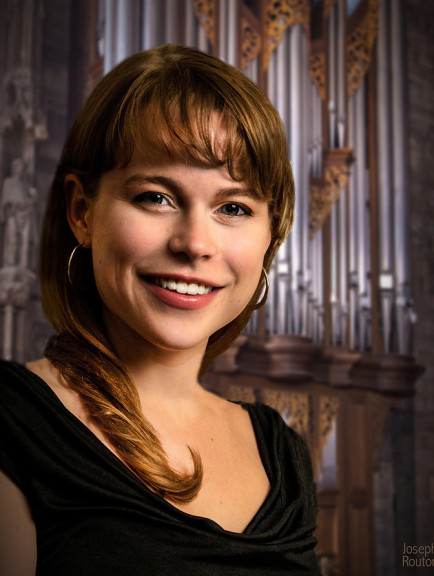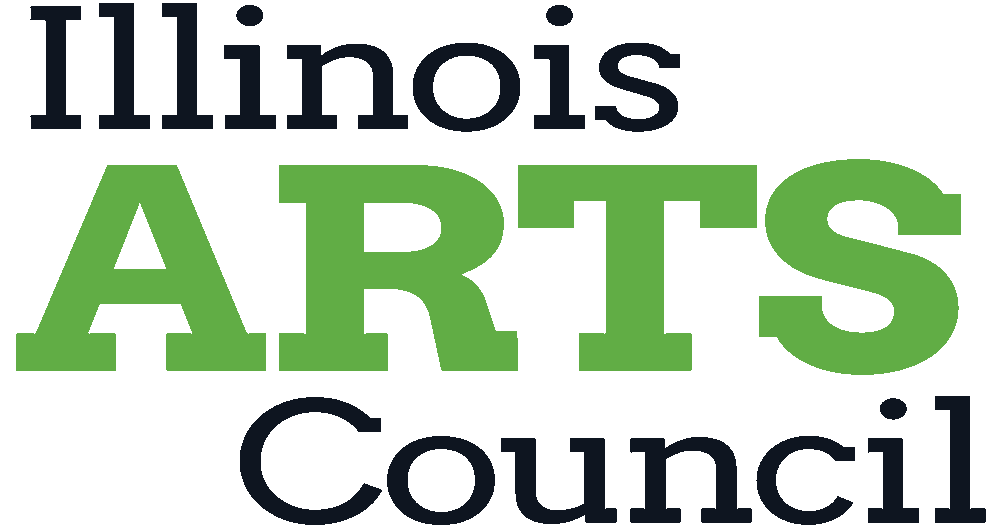Organist Katelyn Emerson to Perform at Wesley UMC in Urbana

Organist Katelyn Emerson
Note: This article was first published in August 2024, as the recital was originally scheduled for September 20. The concert was postponed due to technological issues with the instrument. Scroll to the bottom of this article to see the program for the April 4 recital.
Internationally acclaimed concert organist Katelyn Emerson will play a special recital at 7:30 p.m. on Friday, April 4, 2025, at Wesley United Methodist Church in Urbana. Her concert opens a year of celebratory events in honor of the centenary of the church’s E. M. Skinner organ.
First, a little history: The organ was built in 1925 by Ernest M. Skinner & Company (Opus 521), an organ firm based in Boston, Massachusetts. E. M. Skinner is considered one of the most influential figures in American organ building, responsible for significant sonic and technological advancements in the early twentieth century. Possessing 33 stops and 36/37 ranks, Opus 521 was originally installed in the Recital Hall of Smith Memorial Hall at the University of Illinois at Urbana-Champaign. The instrument was dedicated on October 6, 1925, by Pietro Yon, an Italian-born composer and organist in New York City. It was then relocated to Wesley United Methodist Church in 1966 to make way for a new organ built by the Canadian firm, Casavant Frères.
After 40 years of lessons and recitals, followed by 40 years of regular church service playing, restoration of the Skinner organ was necessary. Having restored the windchests in 2000 following water damage, Buzard Organ Company undertook more extensive restoration work in 2003. This included restoring the console, keyboards, and pedalboard and installing a modern solid state switching system in the console and chamber. (See full details of the restoration and organ specs here.) The work was carried out with utmost care to preserve the original look of the console and integrity of the instrument while improving functionality, and any unused original Skinner components were carefully labeled and stored in the organ chamber.
Organist Katelyn Emerson is no stranger to playing historical instruments, serving on the Membership Committee of the Organ Historical Society and the board of the European Chapter of the American Guild of Organists. Hailed as “one of the world's most promising organists” (Listvinafélag Hallgrímskirkju, Iceland), she maintains a busy career as a performer, lecturer, and pedagogue. She is internationally renowned for her performances throughout North America, Europe, and Asia, where she plays repertoire spanning the 14th to 21st centuries with “impressive technical facility and musicianship” (Cleveland Classical).
When not traveling for performances, Emerson is based both in the United States (in Champaign-Urbana) and the United Kingdom. She is currently a PhD candidate at the Centre for Music and Science at the University of Cambridge. Other academic degrees include an MPhil in Music from Cambridge, a Master of Arts in organ from the Musikhochschule für Musik und Darstellende Kunst in Stuttgart, and dual bachelor’s degrees in organ performance and French from Oberlin College and Conservatory. Between her undergraduate and graduate degrees, she also studied at the Conservatoire à Rayonnement Régional de Toulouse on a Fulbright Study/Research grant.
For Emerson, part of the appeal of the organ as an instrument is the unique connection to history one gains through playing and hearing organs from different eras. The history of the pipe organ is rich, stretching back over two millennia to ancient Rome. Unlike other historical artifacts, musical instruments can be played, allowing the listener to experience them just as people did when they were originally crafted. For most pipe organs, though not the Skinner, this listening often takes place within the same space for which the instrument was designed, further strengthening the connection to the past.
“I take great joy in putting myself back in time and then reconnecting that history with the present through the instruments,” Emerson said. Playing music that dates from the same period as the instrument alongside music that was written before or after it was built can reveal new insights. “These instruments are historical artifacts, but they’re active historical artifacts,” she continued. “They create sound, they put air through pipes, and then they interact with our modern ears so that we can hear sounds that people centuries ago heard and then redigest them within the context of today, which is just such an incredible bridge to our past.”
Emerson, who grew up one hour north of Skinner's factory in Boston, had the privilege of getting to know numerous Skinner organs from a variety of eras that were installed nearby. Through her recital program, she hopes to honor the history of the Skinner organ at Wesley. Though the repertoire is not set in stone yet, she intends to play a variety of music that shows off the instrument’s orchestral colors as well as its heritage as an organ built by a New England firm for an Illinois University during the tumultuous interwar period. [Scroll to the bottom of this article for the updated recital program.]
“I’m really looking forward to a program that synthesizes of these influences,” Emerson said, “as well as the influences on the organ builder and potentially looking into some of the history of the instrument—the people who played it, the people who were exposed to it—and combining the history of the instrument with its present as well as its future.” Thanks to the archival staff at the University of Illinois library, she has managed to get a hold of the original program of the organ's dedication from 1925 and will include some of the original dedication music in her recital.
Touring organ recitalists such as Emerson are required to play instruments made by different builders with different mechanisms, styles, and sonic possibilities. When Emerson tours, she generally allows herself two days before a given concert to familiarize herself with the instrument and the space.
“Every organ is so different, with different numbers of manuals, or keyboards, and different scales of pedals,” Emerson explained. “All of the different sounds are completely unique to each instrument, so an organist really has to invest a lot of time, not only in preparation months in advance for learning the repertoire, but then for adapting the way their bodies and their ears are hearing and feeling the instrument to make it sound as wonderful as possible to everybody in attendance at the concert, whether they’re coming to hear an organ concert for the first time, or whether they’re seasoned concert attendees.”
Fortunately, because Emerson is based part-time in Champaign-Urbana when she is not touring or studying in the UK, she has had more time to practice on the Wesley organ than she usually gets with other instruments. “I’m looking forward to immersing myself in that instrument and really getting to know it much more intimately than I’ve already been able to do,” she said.
This past summer, in addition to a concert tour of Denmark and Germany, Emerson flexed her pedagogical muscles at various organ academies in Canada and the UK. “I absolutely adore teaching, although it can be utterly exhausting when you’re teaching one-on-one lessons 6 to 8 hours a day,” she said. “But it’s so inspiring to see these students, aged 14 to 20 plus, really sinking their teeth into the instrument, being so receptive to different ideas, coming with their own opinions and concepts and being willing to describe them, coming to terms with how to make music on an instrument that’s inherently a machine, and finding ways to create and develop technical abilities in order to translate written notes into sound.”
Emerson enjoys the travel her job requires, saying it enables her to meet people from around the world and share music with them. “In many ways, it’s the people I encounter that bring me the most joy,” she expressed, adding, “I love connecting with people, and I think that also links to the idea of the instruments connecting us with history.”
Don’t miss Katelyn Emerson in concert at 7:30 p.m. on Friday, April 4 at Wesley United Methodist Church in Urbana (1203 W. Green Street). See here for more information.
Recital Program
Fantaisie et Fugue en ré majeur, Op. 73 (2014) – Rachel Laurin (b. 1961)
Erbarm dich mein, o Herre Gott, BWV 721 – Johann Sebastian Bach (1685–1750)
Liebster Jesu, wir sind hier, BWV 731 – Bach
The Chimes of St. Mark (1929) – Antonio Russolo (1877–1943)
Choral Fantasia on “O God our help” (1915) – C. Hubert H. Parry (1848–1918)
Hymn: O God our help in ages past – ST. ANNE
Fantaisie-Improvisation sur l’Ave maris stella (1930–32) – Charles Tournemire (1870–1939)
Humoresque “L’organo primitive” (1918) – Pietro Yon (1886–1943)
Vingt-quatre Pièces de fantaisie, Op. 55, “Naïades” (1926-7) – Louis Vierne (1870–1937)
Fantasie und Fugue über den Namen BACH, S.260 (1870) – Franz Liszt (1811–1886)



